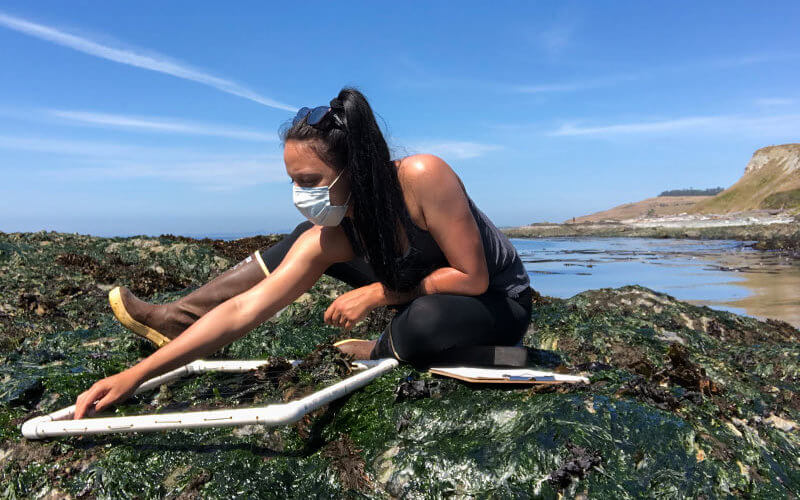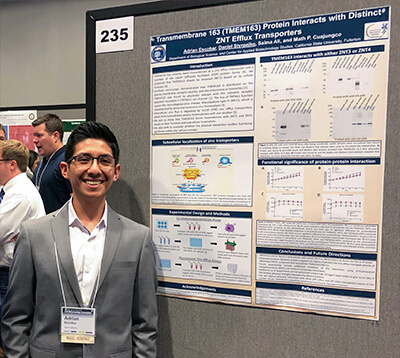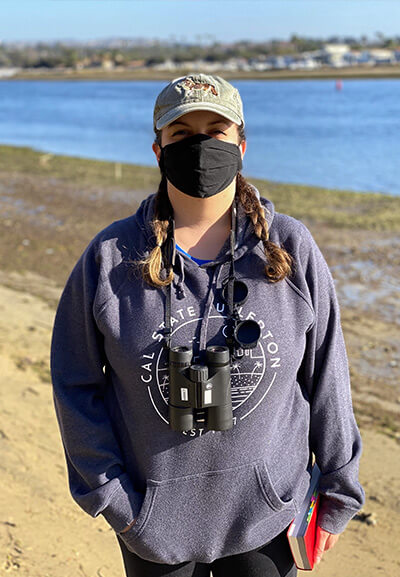
Three Cal State Fullerton students are engaged in research projects that are helping to prepare them as future scientists and STEM leaders.
For their outstanding research and presentation skills, the students were recognized with Presentation Awards at the Society for the Advancement of Chicanos/Hispanics and Native Americans — The National Diversity in STEM Virtual Conference. The awards recognize the next generation of scientists and STEM leaders from historically excluded populations, for making STEM accessible and inclusive, and encourages students to continue pursuing the STEM (science, technology, engineering and mathematics) fields.
The Titan student researchers agreed that the conference gave them the opportunity to hone science communication skills, network with scientists and students from research universities, and become competitive graduate school candidates to pursue a doctorate in their respective fields of study.
Adrian Escobar, biological science major, undergraduate — Life Sciences-Cell and Molecular Biology Presentation Award

In search of drug therapeutics for degenerative brain disorders, diabetes and even cancer, Escobar, a first-generation college student, is studying the TMEM163 protein. This protein, which transports minerals such as zinc, may cause a cellular zinc imbalance if it does not work normally, leading to disease. His work with Math Cuajungco, professor of biological science, suggests that TMEM163 interacts with other proteins to increase or widen its role to ensure that the levels of zinc inside the cells are strictly controlled and kept balanced.
Why is this research important? Zinc is an essential metal that is strictly regulated by our cells, especially brain cells. Diseases like Alzheimer’s, Parkinson’s and Mucolipidosis IV (MLIV) have been reported to exhibit zinc imbalance in the brain. In our lab, we study MLIV, caused by the loss of function of the ion channel called TRPML1 protein. Our lab previously discovered that one of the hallmarks of MLIV disease is an imbalance of zinc levels in lysosomes — the recycling center of the cells. The zinc imbalance in brain cells of MLIV patients may contribute to progressive cell death, further resulting in cognitive and motor impairments. There are currently no known therapeutic approaches to cure MLIV patients, and our goal is to identify biomarkers of pathology, such as zinc transporters for possible targets of therapeutics.
Why does this research interest you? One of the fascinating aspects of science is finding possible solutions to something no one else is studying. My project on TMEM163 allows me to make pioneering discoveries that could hopefully increase our knowledge on its role in human diseases. Our findings will add another piece to a huge puzzle that we, and other researchers, can use to find ways to help patients suffering from various ailments.
Alisa Hernandez, biological science major, undergraduate — Life Sciences-Ecology and Evolutionary Biology Presentation Award

Intrigued by the marine heatwave known as the “Blob” and its impact on the ocean ecosystem, Hernandez, the first in her family to attend college, was inspired to pursue research to help the environment. A scholar in CSUF’s Southern California Ecosystems Research Program, she investigated the Blob of warm water that penetrated hundreds of meters deep and stretched from the Gulf of Alaska to Baja California during its peak in the 2013-14 winter months.
As part of SCERP’s summer course on “Problems in Environmental Biology” and under the guidance of faculty mentors William “Bill” Hoese and Kristy Forsgren, she and five other new SCERP scholars studied how the Blob impacted the total annual catch amounts of different marine fish that commercial fisheries reported. These included Northern anchovy, Pacific sardine, market squid and yellowtail amberjack. The study found that species that had preferences for warmer water temperatures, such as Northern anchovy, experienced a catch increase during the Blob, while species that preferred cooler waters, such as market squid, declined in catch.
Why is this research important? This research is vital to understanding our environment, the vulnerable species and how humans are impacting them. Marine heatwaves have become more frequent and more intense in recent years, which is thought to be related to global climate change. These water temperature changes, even if only by a degree or two, can have dramatic effects on marine species — and can change their reproductive habits, including spawning density, location and/or timing. Understanding how oceanic water temperature changes impact marine species is key to the survival of our ecosystems.
Why does this research interest you? What originally stood out to me was the name of the heatwave, the Blob, which was strange enough. The Blob is so mysterious with very little known about its origins and effects. I’ve gained research skills and explored my interest in conservation and ecological issues, as well as learned about pressing biological problems in our ecosystems.
Angelina Zuelow, biology graduate student — Life Sciences-Marine Sciences Graduate Oral Presentation Award

Zuelow, past president and current vice president of CSUF’s SACNAS student chapter, is examining the effect of Egregia menziesii, commonly known as feather boa kelp. The canopy-forming kelp is found on intertidal communities along the entire West Coast. Under the mentorship of Jennifer L. Burnaford, professor of biological science, since summer 2019, Zuelow has been conducting experiments in both Southern California and northern Washington and will continue her study through this spring.
Canopy-forming seaweeds provide shade for smaller algae and invertebrates in intertidal communities during low tide — when the shore is exposed to air and full-strength sunlight. However, kelp canopies can negatively affect other organisms by limiting other organism settlement, causing physical disruption and trapping sand. Her results so far show no evidence of sand trapping in either California or Washington. Zuelow has found that the kelp can reduce temperature during peak summer low tides, sometimes by 20 degrees Fahrenheit.
The intertidal community structure in Washington appears to be driven by seasonal changes, while that trend is not consistent in California, Zuelow noted. Another season of data will provide further answers on the kelp’s influence on the community.
Why is this research important? These findings add to the idea that the effect of foundation species can be extremely dependent on outside factors. Foundation species, such as corals in coral reefs, have a large impact on the community by the structure they provide and the environmental conditions they influence. For example, in a redwood forest on a hot sunny day, the trees shade the sun and create much cooler conditions. This same thing can happen in kelp forests. However, although we know foundation species are important, we don’t know how much their effect varies from location to location. My study is important because I am examining if feather boa kelp always acts as a foundation species or if the kelp’s community role is different at different sites, potentially determined by environmental conditions.
Why does this research interest you? I am a true algae lover. I wanted to study two things: algae and community ecology. I get the most questions about the algae mimic aspect. When you visit an aquarium, the algae you see in the aquariums is plastic mimic. I have used the exact same mimic algae and placed them in the field to see how they might alter the environment.